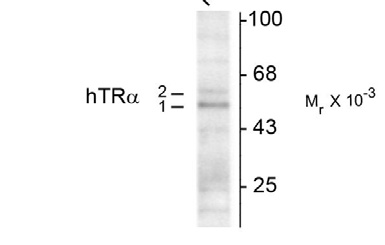Thyroid Hormone Receptor, α1/α2-Isotype Antibody
Affinity purified mouse monoclonal antibody.
- SPECIFICATION
- CITATIONS
- PROTOCOLS
- BACKGROUND

Application
| WB |
|---|---|
| Primary Accession | P10827 |
| Reactivity | Human, Rat |
| Predicted | Mouse, Monkey |
| Host | Mouse |
| Clonality | monoclonal |
| Isotype | IgG1 |
| Clone Names | 2103 |
| Calculated MW | 50/58 KDa |
| Gene ID | 7067 |
|---|---|
| Gene Name | THRA |
| Other Names | Thyroid hormone receptor alpha, Nuclear receptor subfamily 1 group A member 1, V-erbA-related protein 7, EAR-7, c-erbA-1, c-erbA-alpha, THRA, EAR7, ERBA1, NR1A1, THRA1, THRA2 |
| Target/Specificity | Synthetic peptide corresponding to amino acid residues from the N-terminal region conjugated to KLH. |
| Dilution | WB~~ 1:1000 |
| Format | Prepared from mouse ascites by ammonium sulfate precipitation followed by affinity purification on a protein G column. |
| Antibody Specificity | Specific for the ~50k TR-α1 and the ~58k TR-α2 proteins. |
| Storage | Maintain refrigerated at 2-8°C for up to 6 months. For long term storage store at -20°C in small aliquots to prevent freeze-thaw cycles. |
| Precautions | Thyroid Hormone Receptor, α1/α2-Isotype Antibody is for research use only and not for use in diagnostic or therapeutic procedures. |
| Shipping | Blue Ice |

Thousands of laboratories across the world have published research that depended on the performance of antibodies from Abcepta to advance their research. Check out links to articles that cite our products in major peer-reviewed journals, organized by research category.
info@abcepta.com, and receive a free "I Love Antibodies" mug.
Provided below are standard protocols that you may find useful for product applications.
Background
Thyroid hormones are essential for development of the central nervous system and deficits in these hormones during development affects such cognitive functions as learning and memory (Ambrogini et al., 2005; Chan and Kilby, 2000). Thyroid hormones exert their physiological role mainly through binding to specific nuclear receptors including the predominant isoforms of thyroid hormone receptors TRα1, TRα2, TRβ1 and TRβ2. TRα1, TRβ1 and TRβ2 bind T3 with high affinity and also bind to thyroid hormone response elements (TREs) on chromatin to regulate the transcriptional processes in several target tissues, including adult rat brain (Constantinou et al., 2005).
References
Ambrogini P, Cuppini R, Ferri P, Mancini C, Ciaroni S, Voci A, Gerdoni E, Gallo G (2005) Thyroid hormones affect
neurogenesis in the dentate gyrus of adult rat. Neuroendocrinology 81:244-253.
Chan S, Kilby MD (2000) Thyroid hormone and central nervous system development. J Endocrinol 165:1-8.
Constantinou C, Margarity M, Valcana T (2005) Region-specific effects of hypothyroidism on the relative expression
of thyroid hormone receptors in adult rat brain. Mol Cell Biochem 278:93-100.
If you have used an Abcepta product and would like to share how it has performed, please click on the "Submit Review" button and provide the requested information. Our staff will examine and post your review and contact you if needed.
If you have any additional inquiries please email technical services at tech@abcepta.com.













 Foundational characteristics of cancer include proliferation, angiogenesis, migration, evasion of apoptosis, and cellular immortality. Find key markers for these cellular processes and antibodies to detect them.
Foundational characteristics of cancer include proliferation, angiogenesis, migration, evasion of apoptosis, and cellular immortality. Find key markers for these cellular processes and antibodies to detect them. The SUMOplot™ Analysis Program predicts and scores sumoylation sites in your protein. SUMOylation is a post-translational modification involved in various cellular processes, such as nuclear-cytosolic transport, transcriptional regulation, apoptosis, protein stability, response to stress, and progression through the cell cycle.
The SUMOplot™ Analysis Program predicts and scores sumoylation sites in your protein. SUMOylation is a post-translational modification involved in various cellular processes, such as nuclear-cytosolic transport, transcriptional regulation, apoptosis, protein stability, response to stress, and progression through the cell cycle. The Autophagy Receptor Motif Plotter predicts and scores autophagy receptor binding sites in your protein. Identifying proteins connected to this pathway is critical to understanding the role of autophagy in physiological as well as pathological processes such as development, differentiation, neurodegenerative diseases, stress, infection, and cancer.
The Autophagy Receptor Motif Plotter predicts and scores autophagy receptor binding sites in your protein. Identifying proteins connected to this pathway is critical to understanding the role of autophagy in physiological as well as pathological processes such as development, differentiation, neurodegenerative diseases, stress, infection, and cancer.


